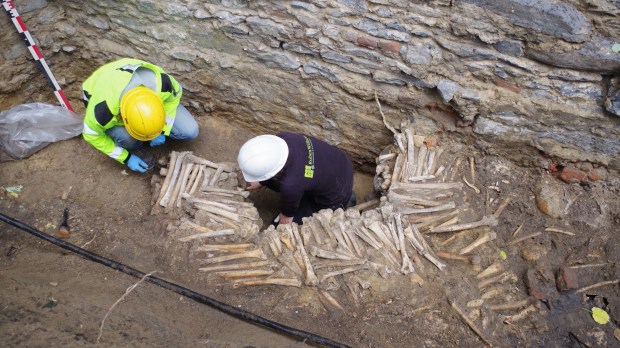Lenten Campaign 2025
This content is free of charge, as are all our articles.
Support us with a donation that is tax-deductible and enable us to continue to reach millions of readers.
Restoration of the Jan Van Eyck painting “Adoration of the Mystic Lamb” in Belgium’s St. Bavo’s cathedral revealed a surprisingly human face on the lamb that is a symbol of Christ.
Now, workers restoring the Ghent cathedral have made another surprising discovery: walls made out of human bones.
For 11 months the firm of Ruben Willaert in Bruges has been excavating in and around the former church of St. John in Ghent — now St. Bavo’s Cathedral. The area around the church was a graveyard from the mid-12th century until 1784.
“On archaeologically examined graveyards we often see large pits/layers with lots of loose human bones, from clearing older graves, but we have never seen structures like walls which are intentionally built with human bones,” Janiek De Gryse, project leader for the archaeological team, told Aleteia.
De Gryse said that in the past, when cemeteries were cleared, often it was done rapidly and inaccurately.
“The people who cleared the graves didn’t bother to collect the small or very fragile bones (e.g. the vertebrae, ribs or bones from the hand or the foot), De Gryse said. “This way of collection results in a natural selection of the bones. In the case of the ‘bone-walls’ of Ghent, there is an extra dimension to it. The bones from the upper limbs are absent; the walls consist only of bones from the lower limbs.”
De Gryse’s team is examining the findings and wondering if the practice was merely a practical thing — piling up bones in a very compact way — or if there was also a religious/spiritual dimension to it.
“The walls were made mainly of the thigh and shin bones of adults,” De Gryse said. “Between the walls, the space was filled with skulls, many of them shattered. The bones are from men as well as women, of all ages. There is no selection in age or sex.”
She said that radiocarbon dating put the bones mainly from the second half of the 15th century and that they appear to have been from a time when a part of the graveyard was being cleared, possibly to make place for new burials. The walls, however, were probably built in the 17th to the first half of the 18th century, the team thinks.
“When clearing a churchyard, the skeletons cannot just be thrown away,” De Gryse said. “Given that the faithful believed in a resurrection of the body, the bones were considered the most important part. That is why stone houses were sometimes built against the walls of city graveyards to house skulls and the long bones in what is called an ossuary.”
The excavation has been carried out in preparation for the construction of a new visitor’s center in the cathedral, dedicated to the Van Eyck altarpiece, the Adoration of the Mystic Lamb.
The Brussels Times reported that the archaeological find will not become a tourist attraction, but that the bones will be removed. They will be examined in association with the University of Ghent.

